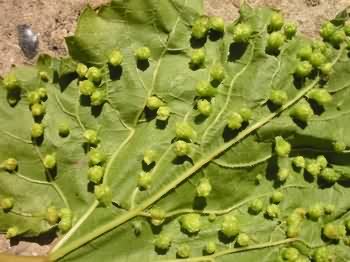Pests
Viteus vitifolii Fitch - Grape Phylloxera
Systematic position.
Class Insecta, order Homoptera, suborder Aphidinea, family Phylloxeridae, genus Viteus Shimer.Synonyms.
Dactylosphaera vitifolii Fitch, Phylloxera vastatrix Planchon.Grapevine Phylloxera, Root Louse, Vine Fretter
Biological group.
Pest of vine.Morphology and biology.
Eggs or 1st instar larvae hibernate. Overwintering eggs are located in bark cracks, and overwintering larvae are on roots. Hatching from overwintered egg, larva produces gall on the surface of young leaves. Gall-making aphid belongs to a gallicola form. After 4 molts inside gall the larva transforms into fundatrix (wingless female is yellowish-green in color), which lays about 150-200 eggs during parthenogenetic reproduction. Body length of the fundatrix, 1-1.25 mm. Gallicola form of phylloxera with piercing and suctorial type of mouthpart, closed intestine, and extra intestinal digestion. Gallicola has few overlapping parthenogenetic generations. In the beginning of growing season the most of the progeny of gallicolous females remain on leaves, but some of them migrate in the soil on the roots (radicola form). Towards autumn gallicolae decrease in progeny and radicolae increase on the contrary. Radicolae differs from gallicolae in long proboscis, structure of eggs, and in lower fertility (about 50 eggs). Radicolae are greenish in spring and brown in summer. Body length of radicolae, 0.8-1.2 mm. Radicolous aphids cause 2 types of gall-like formations on roots: nodosities and tuberosities. In autumn at soil temperature 7-8шC the radicolae finish feeding, and larvae of the older instars die off. Wintering larvae stay immovable on roots to 3 cm in diameter with their proboscis being stuck into the root. Most of larvae during hibernation concentrate at a depth to 50 cm. Eggs survive at air temperature to -20-30шC, but larvae perish at -8шC in soil. Spring activity of the overwintered larvae begins at soil temperature about 13шC. After four molts the larvae transform into alate females with parthenogenetic type of reproduction. The 1st instar larvae (crawlers) migrate along root system and sometimes appear on soil surface. Some of the radicolous larvae transform into nymphs at soil temperature about 25шC. Nymphs leave root and transform into winged virginoparae. For the first time they are goldish-yellow, later orange with black thorax. Compound eyes and ocelli reddish, antennae 3-segmented, abdomen 9-segmented, fusiform. Virginoparae lay small and large eggs on leaves and sprouts, and thereafter males and females with reduced mouthparts hatch. After pairing females lay only 1 large egg into bark crack on vine of at least 2 years old.Distribution.
The pest came from Northern America. It was introduced with host plants to the majority of countries of Europe, Afrika, Southern America, Middle East, and to Japan, Korea, China, Australia, New Zealand. In Russia it was registered for the first time in Crimea at the end of 19th century. It is distributed now in Moldova, Ukraine, in Rostov Region, Stavropol and Krasnodar Territories of Russia, in the Caucasus.Ecology.
Holocyclic species with a two-year cycle as a rule. Full cycle of the phylloxera development occur only on American varieties and on American-European hybrids of vine. Gallicola form is absent on European varieties of Vitis vinifera. To 4-5 parthenogenetic generations develop in Moldova and Ukraine, 7-8 ones in Transcaucasia. Egg develops 4-8 days, larva - 10-36 days. Adult gallicola female lives much longer than larva. In the South of Ukraine 37 polyphagous predatory species of arthropods are marked, feeding by gallicolae, and 20 species feeding by radicolae. Sandy soil is unfit for the pest.Economic significance.
It is a quarantine species. It damages in larval and adult stages. Gall-like formations on roots decay, and vine die off during a few years after injure. Control measures include destruction of injured vineyards, growing of resistant vine varieties, and fumigation of the vine root system.Related references:
Gorkavenko, E.B. 1976. Entomophages of grape phylloxera and their role in reducing of the pest population in the southern areas of Ukraine. In: Kozar. I.M., ed. Proceedings of VIZR, Issue 46, Grape phylloxera and its control. Leningrad. P. 88-97. (in Russian).Gorkavenko, A.S., Gorkavenko, E.B. 1976. Some biological peculiarities of the root phylloxera life cycle. In: Kozar. I.M., ed. Proceedings of VIZR, Issue 46, Grape phylloxera and its control. Leningrad: Kolos. P. 26-41 (in Russian).
Kazas, I.A., Gorkavenko, A.S. & Poichenko V.M. 1960. Grape phylloxera and its control. Simferopol: Crymizdat. 230 p. (in Russian).
Marechek, G.I. 1966. Viteus vitifolii Fitch. and Polychrosis botrani Schiff. on grape. In: Polyakov I.Ya. & Chumakov A.E., eds. Proceedings of VIZR, Issue 28, Distribution of agricultural pests and diseases in 1965. Leningrad: Kolos. P. 203-204 (in Russian).
Printz, Ya.I. 1965. Grape phylloxera and its control. Moscow: Nauka. 295 p. (in Russian).
Shamonin, M.G., Smetnik, A.I., eds. 1986. Plant quarantine in the USSR. Moscow: Agropromizdat. 256 p. (in Russian).
Shchegolev, V.N., ed. 1955. Agricultural Entomology. Leningrad & Moscow: Sel.khozgiz. 616 p. (in Russian).
Stevenson A.B. 1964. Seasonal history of root-infesting Phylloxera vitifoliae (Fitch) (Homoptera, Phylloxeridae) in Ontario. The Canadian Entomologist. V. 96 (7). Ottava. P. 979-987.
Vasyutin A.S., ed. 2003. Reference-book on quarantine phytosanitary state of the Russian Federation for January 1, 2003. Moscow: MSKH RF, 102 p. (in Russian).


